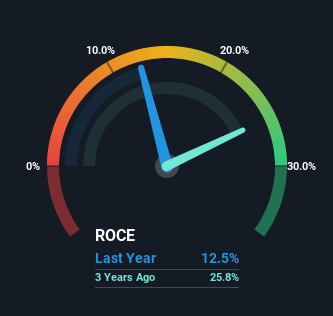
To find a multi-bagger stock, what are the underlying trends we should look for in a business? Firstly, we'd want to identify a growing return on capital employed (ROCE) and then alongside that, an ever-increasing base of capital employed. Basically this means that a company has profitable initiatives that it can continue to reinvest in, which is a trait of a compounding machine. Although, when we looked at Doximity (NYSE:DOCS), it didn't seem to tick all of these boxes.
Understanding Return On Capital Employed (ROCE)
Just to clarify if you're unsure, ROCE is a metric for evaluating how much pre-tax income (in percentage terms) a company earns on the capital invested in its business. To calculate this metric for Doximity, this is the formula:
Return on Capital Employed = Earnings Before Interest and Tax (EBIT) ÷ (Total Assets - Current Liabilities)
0.13 = US$121m ÷ (US$1.1b - US$106m) (Based on the trailing twelve months to December 2022).
So, Doximity has an ROCE of 13%. In absolute terms, that's a satisfactory return, but compared to the Healthcare Services industry average of 5.6% it's much better.
See our latest analysis for Doximity

In the above chart we have measured Doximity's prior ROCE against its prior performance, but the future is arguably more important. If you'd like, you can check out the forecasts from the analysts covering Doximity here for free.
So How Is Doximity's ROCE Trending?
In terms of Doximity's historical ROCE movements, the trend isn't fantastic. Over the last three years, returns on capital have decreased to 13% from 26% three years ago. Although, given both revenue and the amount of assets employed in the business have increased, it could suggest the company is investing in growth, and the extra capital has led to a short-term reduction in ROCE. If these investments prove successful, this can bode very well for long term stock performance.
On a side note, Doximity has done well to pay down its current liabilities to 9.9% of total assets. That could partly explain why the ROCE has dropped. What's more, this can reduce some aspects of risk to the business because now the company's suppliers or short-term creditors are funding less of its operations. Some would claim this reduces the business' efficiency at generating ROCE since it is now funding more of the operations with its own money.
In Conclusion...
Even though returns on capital have fallen in the short term, we find it promising that revenue and capital employed have both increased for Doximity. And there could be an opportunity here if other metrics look good too, because the stock has declined 36% in the last year. As a result, we'd recommend researching this stock further to uncover what other fundamentals of the business can show us.
Doximity could be trading at an attractive price in other respects, so you might find our free intrinsic value estimation on our platform quite valuable.
While Doximity may not currently earn the highest returns, we've compiled a list of companies that currently earn more than 25% return on equity. Check out this free list here.
New: Manage All Your Stock Portfolios in One Place
We've created the ultimate portfolio companion for stock investors, and it's free.
• Connect an unlimited number of Portfolios and see your total in one currency
• Be alerted to new Warning Signs or Risks via email or mobile
• Track the Fair Value of your stocks
Have feedback on this article? Concerned about the content? Get in touch with us directly. Alternatively, email editorial-team (at) simplywallst.com.
This article by Simply Wall St is general in nature. We provide commentary based on historical data and analyst forecasts only using an unbiased methodology and our articles are not intended to be financial advice. It does not constitute a recommendation to buy or sell any stock, and does not take account of your objectives, or your financial situation. We aim to bring you long-term focused analysis driven by fundamental data. Note that our analysis may not factor in the latest price-sensitive company announcements or qualitative material. Simply Wall St has no position in any stocks mentioned.
About NYSE:DOCS
Doximity
Operates a cloud-based digital platform for medical professionals in the United States.
Flawless balance sheet with solid track record.
Similar Companies
Market Insights
Community Narratives



